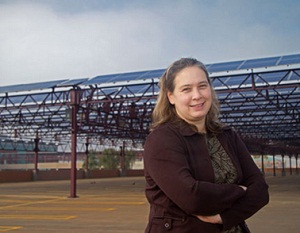NSF, DOE, companies fund new solar research facility at ASU
 Arizona State University will host the new Quantum Energy and Sustainable Solar Technologies (QESST) energy research center at ASU’s Ira A. Fulton Schools of Engineering. The center, which will help coordinate and conduct research—including developing prototypes—will work with other institutions in an attempt to make solar more economically viable through quantum mechanics.
Arizona State University will host the new Quantum Energy and Sustainable Solar Technologies (QESST) energy research center at ASU’s Ira A. Fulton Schools of Engineering. The center, which will help coordinate and conduct research—including developing prototypes—will work with other institutions in an attempt to make solar more economically viable through quantum mechanics.
QESST will be directed by Christiana Honsberg, a professor in the School of Electrical, Computer and Energy Engineering.
“An expanding global economy is bringing an unquenchable demand for more electrical power,” Honsberg said in a press release. “It will become vital to progress throughout the 21st century to have the benefits of alternative energy sources that solar power can provide through photovoltaic technologies.”
The new center is being supported by $18.5 million from the National Science Foundation (NSF) and Department of Energy (DOE) during its first five years.
Other funding will come from companies, though the amounts have not yet been finalized, according to ASU spokesperson Joe Kullman.
“They [i.e., those companies’ investments] were all contingent upon getting the funding from DOE and NSF,” he said. “Some of these are already in progress. That news is yet to come.”
Since ASU already has a solar testing facility, it’s an ideal location to test more solar.
“There’s a big branch of this that’s a test bed. The director for that is here at ASU,” Kullman said.
The institution will work with other institutions to develop more economical forms of photovoltaics and prepare them for commercialization. The California Institute of Technology, Massachusetts Institute of Technology, the University of Delaware and the University of New Mexico are among partners in the research, according to an ASU press release.
Research will look across the photovoltaic spectrum of products.
“It is focused on photovoltaics, but not just silicon,” Kullman said. “Silicon is probably the central focus, but we have research into using a number of other materials to see what they can do with those.”
The university is already doing a lot with solar.
“We have a lot of stuff going in on in terms of photovoltaic materials,” Kullman said.
That includes physics, testing, mechanics and more.
“It’s a whole array of things, not just one or two things. I think that’s one of the lead reasons why we were picked as a lead institution,” he said.
Pictured: QESST Director, Christina Honsberg, courtesy of ASU.



